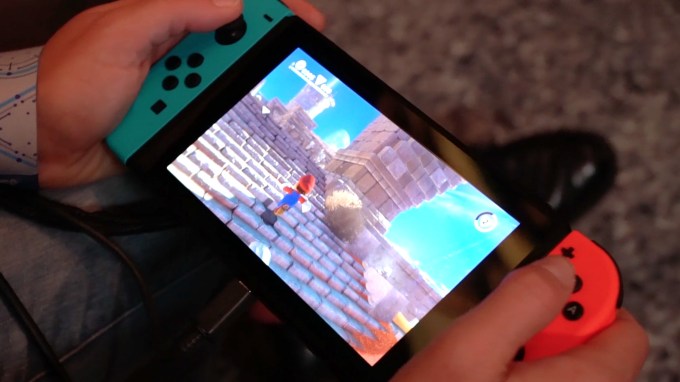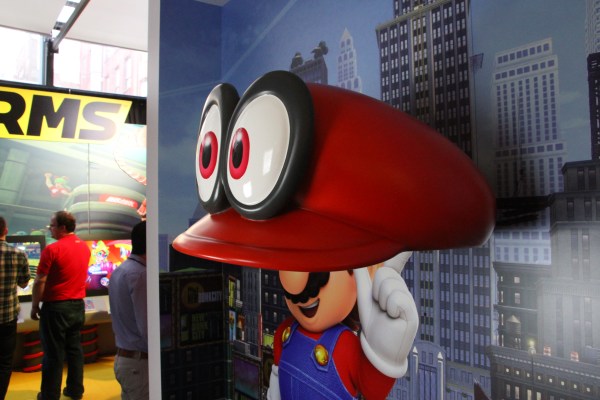Nostalgia sells. No one knows that better than Nintendo. Much of the company’s intellectual property is well past the 30 year mark at this point, and yet it manages to find new scenarios for its most popular franchises year in and year out, reinventing its stable of characters for each subsequent platform.
This year’s E3 was another perfect example. There was no new hardware for the show and a number of the company’s biggest games were previously announced. Nintendo’s online presser rolled out trailer after trailer of familiar faces, and yet the showing was widely regarded as a triumph for the gaming giant by the online community and many in the press. The big takeaway? Give the people what they want.
Well, to a point, at least. Nintendo has remained staunchly and often defiantly independent for most of its existence, to both its credit and sometime detriment. When TechCrunch’s own Jordan Crook attempted to draw a parallel with Apple during an interview on the show floor of E3 this week, Sales and Marketing head Doug Bowser (real last name), batted down the comparison, insisting, “Nintendo likes to take the Nintendo approach.”
Fair enough, I guess. When you’ve been doing this thing for as long as Nintendo has, you’re entitled to define things on your own terms. The company hasn’t often kowtowed to larger industry trends. As its chief competitors Sony and Microsoft have engaged in a decade and a half long arms race, Nintendo has just been Nintendo. The company hasn’t spent much time focused on graphics or processing power, instead looking for unique ways to reinvent its own gaming experience, from the motion controlled Wii to last year’s Switch, which straddles the line between a living room and portable experience.
From the outside, Nintendo’s decision making process can sometimes be down right baffling. That undoubtedly applies to the NES Classic Edition, the set-top gaming emulator the company killed in spite of unprecedented demand. Asked why the company pulled the product at the height of its powers, Bowser explains that the product was an opportunity to relearn what seems to be a fairly obvious lesson in Nintendoland. “We’ve learned a lot from the NES Classic,” he explains. “We’ve learned there’s a real passion for retro gaming.”
So why wasn’t passion enough to keep the product on the market until demand died down? Apparently the company thought its attention was better spent elsewhere. “The NES Classic was originally intended to be a holiday item,” he continues. “And obviously there was high demand. So we doubled down and continued to produce it as we went into the next quarter. But we decided we wanted to focus on other areas. So we’re not producing any more at this point. But we’ve learned a lot.”
The sentiment seems to fly in the face of the transformation the company says it has experienced over the last couple of years. When I interviewed Reggie Fils-Aime around the iOS release of Super Mario run last year, Nintendo of America’s President told me, “We have reshaped our overall business mission and key strategies that are driving it. Our business mission is to make people smile through the use of our IP.”
That sentiment certainly seems in line with keeping the super successful NES Classic on the market. Though, to be fair, that shift in thinking was due in no small part to the underperforming Wii U, which cased many to prematurely declare the death of Nintendo. The Switch’s release appears to have turned things right around.
According to the company’s own reporting, the Switch was its fastest selling console for the first two months. Recently released internal number from GameStop reflected that, noting that the Switch was outselling the wildly popular Wii by ten percent for the first two months of its own release. The new console also outsold both the Xbox One and PS4 in its first couple of months, according to NPD.

That’s not to say, of course, that Nintendo has backed away from pursuits outside of the Switch. It still has a number of smartphone titles in the works (though none really got much face time at E3). And the company had done deals with Universal Studios and a handful of clothing companies aimed at increasing its profile.
“We’ve got a strategy where we want to increase the number and frequency of touch points with Nintendo properties with consumers,” says Bowser. “We’re doing that in a couple of ways. First, the console business with the Switch — through our dedicated console platform. We’re also doing our mobile business. We’re doing it through licensing agreements, such as the Vans deal or the Uniqlo deal that we did this year. And we’re doing it with out of door experiential opportunities, such as Universal Studios.”
Even Nintendo’s sometimes confusing internal logic can’t argue with the success rate of partnerships. As it’s acknowledge on numerous occasions, the success of the Niantic produced Pokemon Go was a principle driving factor in sales for Pokemon Sun and Moon on the 3DS. The math is pretty simple: the mobile game got people excited again about an old property and they grabbed all the Pokemon stuff they can find. Gotta catch ‘em all, etc.
The company is also continuing to explore new partnerships. Arguably the most exciting Nintendo news of the week came from a third party. Bandai Namco announced that it would be offering a VR Mario Kart experience using the HTC Vive in Japanese arcades. As was the case with past partnerships like Pokemon Go, the licensing deal has given Nintendo the ability to put its characters in experiences it wouldn’t have cooked up in-house, due to its longstanding commitment to a closed hardware/software ecosystem.
And like Pokemon Go, Mario Kart VR is one of the most exciting Nintendo related announcements in recent memory. This relative openness has given the company an interesting sort of loophole. It’s clear that Nintendo’s not ready to commit to virtual reality on its own platform, but players now don’t have to be deprived of a VR Mario experience. Well, in Japan, at least.
“There’s obviously some VR opportunity on the floor,” says Bowser. “For us, that’s not our focus right now, but we always look at opportunities and where we can take gaming experience further. But we have nothing more to announce right now.”
Nintendo’s not tipping its hand on VR. It never does. That’s bad form for a company that got its start selling playing cards. But hopefully the Switch’s success doesn’t signal the beginning of a retreat from its commitment to new avenues like mobile. Those experiences have played a key role in helping reinvigorate the brand. And if Mario Kart VR proves a big hit in Japan, maybe virtual reality will be right for Nintendo, after all.
